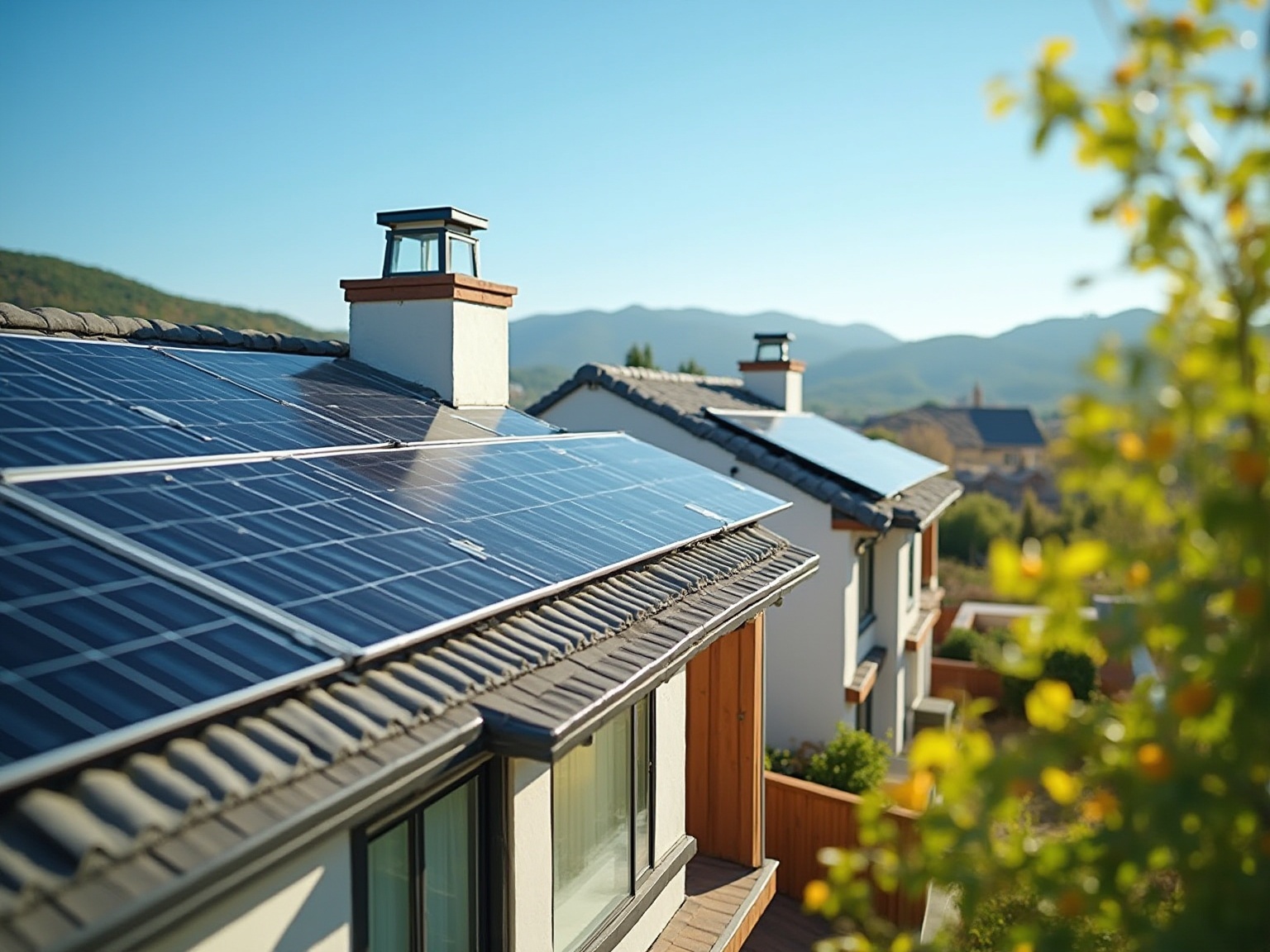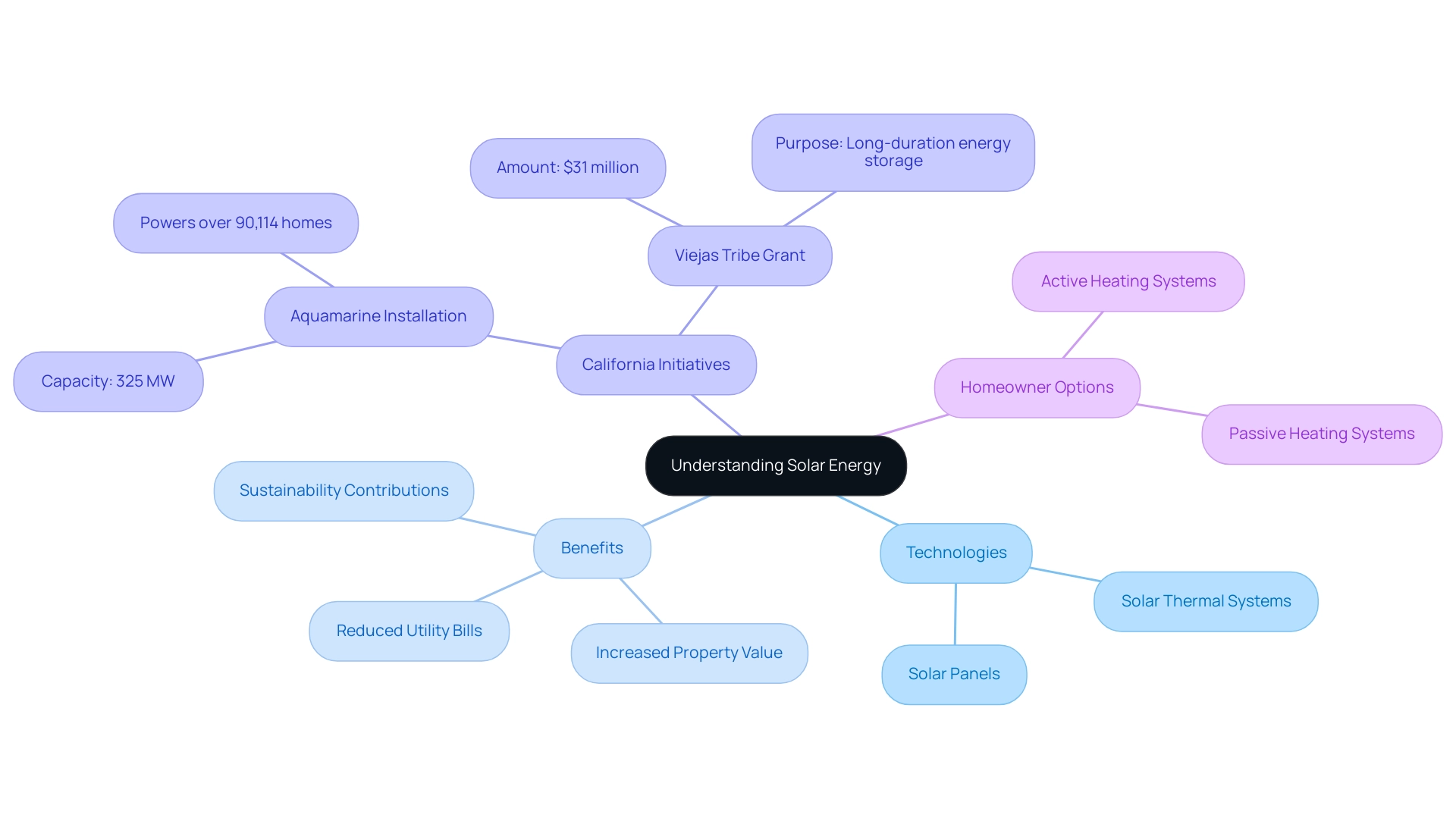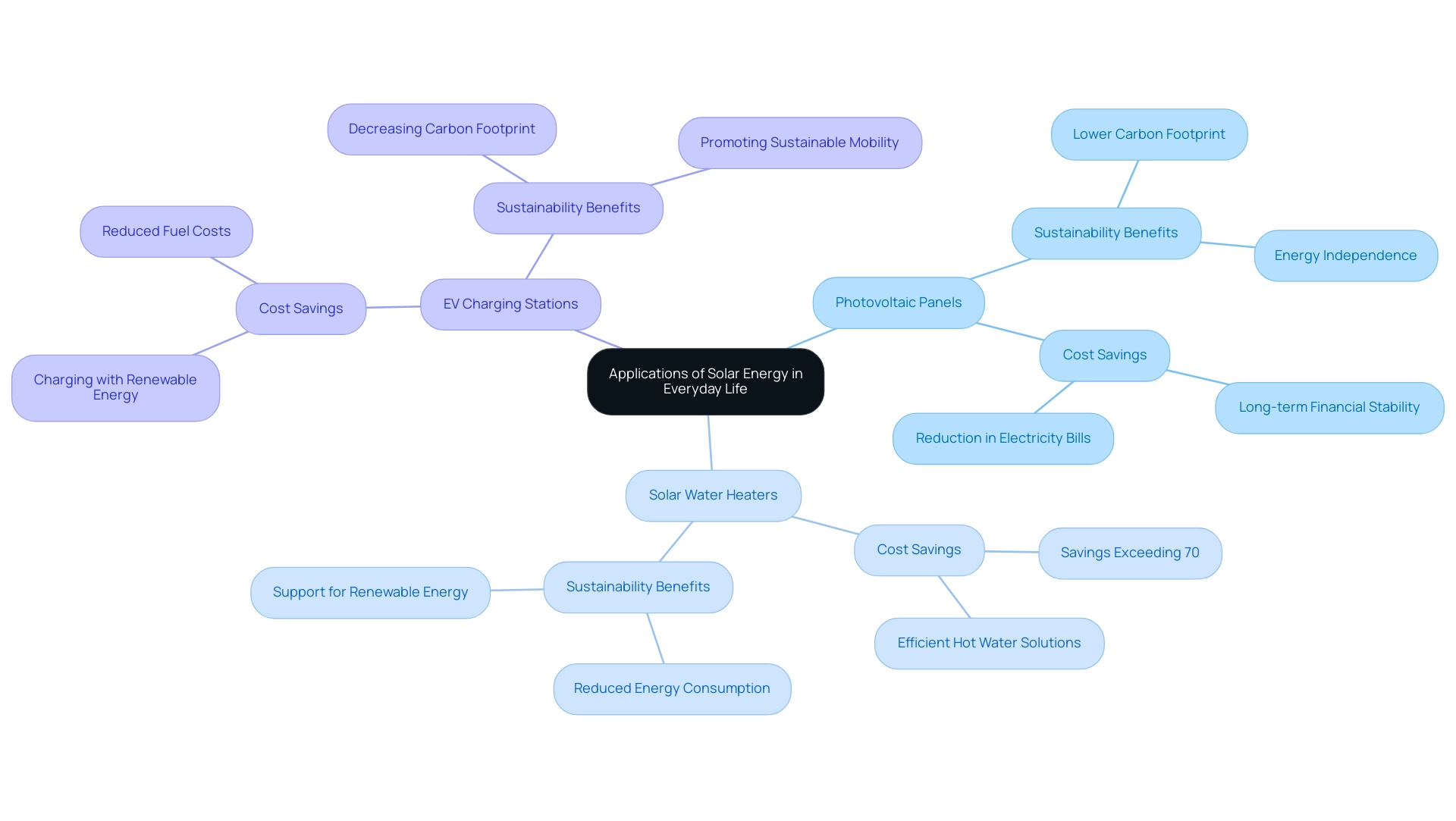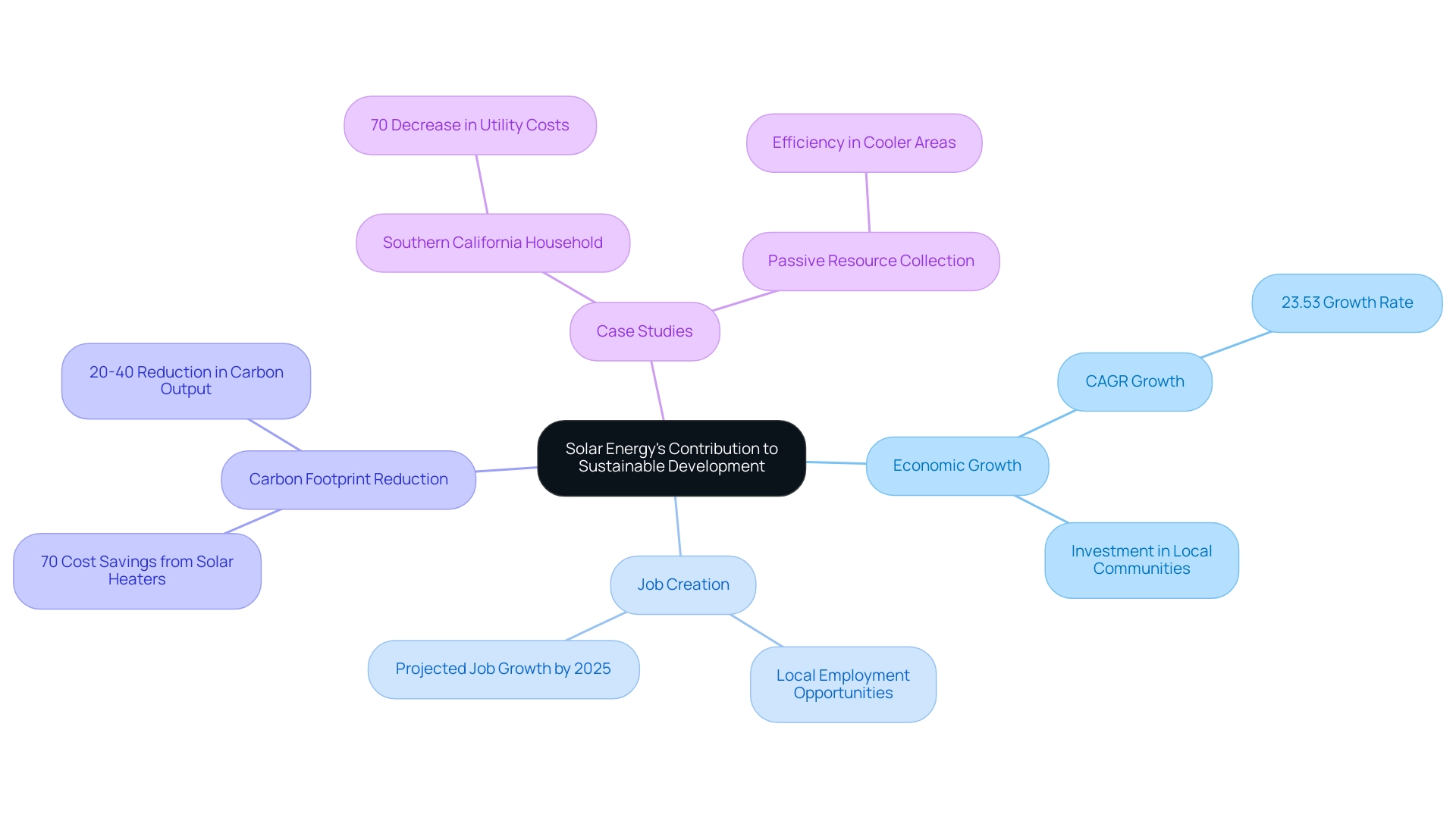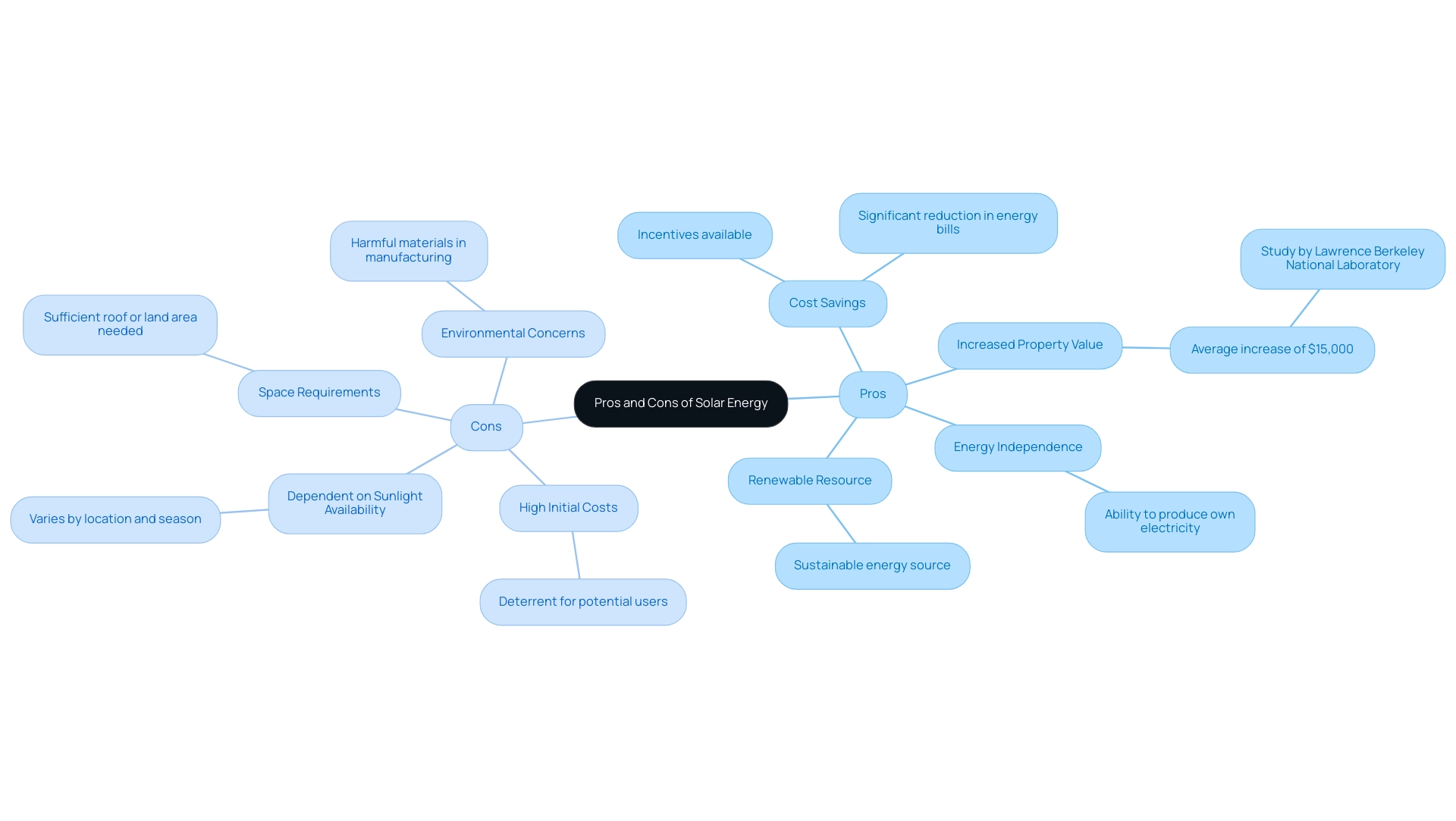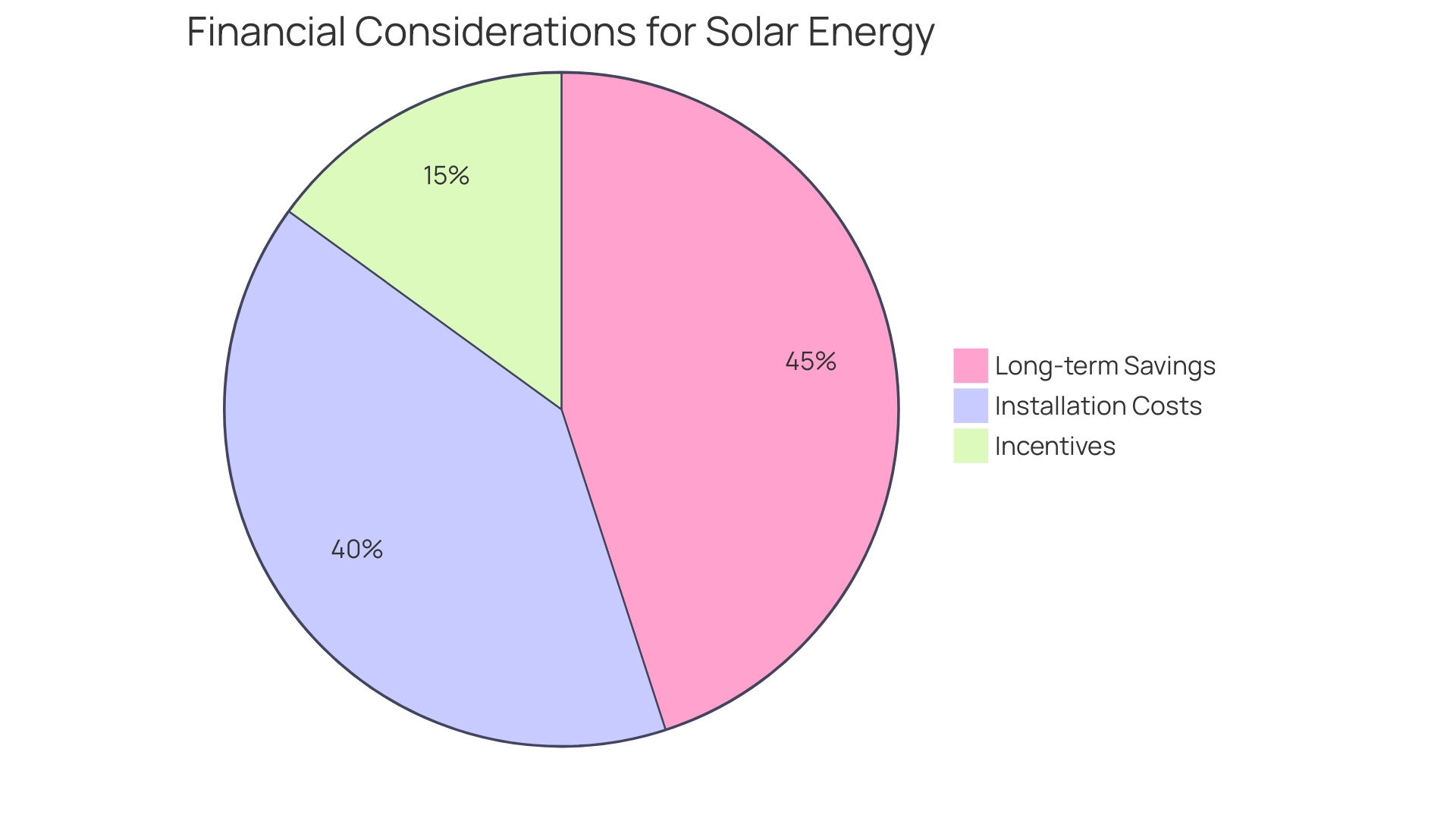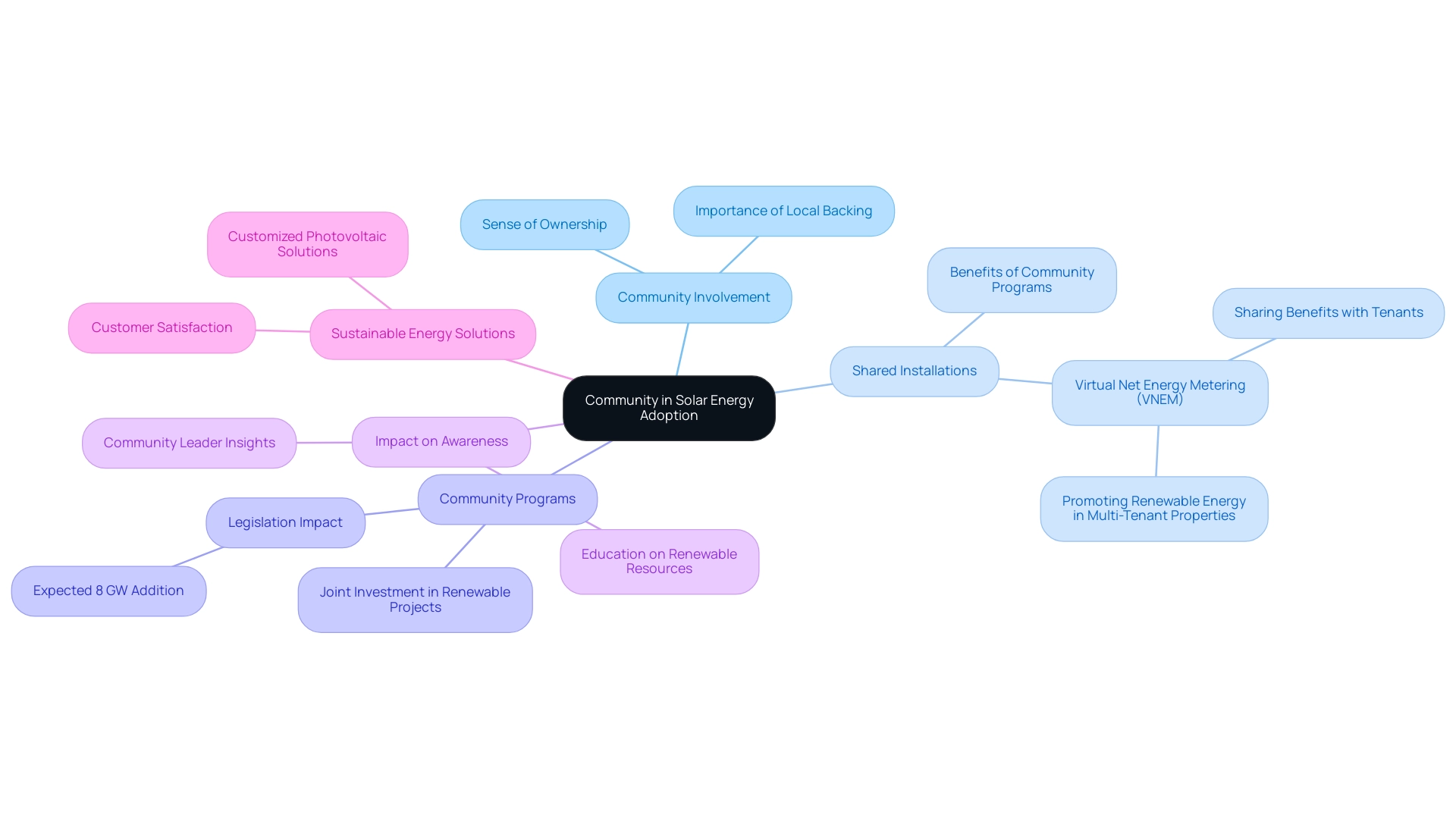Overview
Source Solar is dedicated to harnessing solar energy through technologies like photovoltaic panels and solar thermal systems. We understand that many homeowners are concerned about rising energy bills and the impact of fossil fuels on our planet. By embracing solar energy, not only can you reduce your reliance on these traditional energy sources, but you can also lower your monthly bills. Imagine a future where you have more control over your energy costs, fostering a sense of independence and security in your home.
These solar systems play a pivotal role in the transition to sustainable energy, significantly contributing to combatting climate change. Together, we can create a cleaner environment while also fostering economic growth through job creation in the renewable energy sector. It’s common to feel overwhelmed by the options available, but we are here to support you every step of the way.
Consider the benefits:
- Reduced energy costs
- Increased property value
- A positive impact on the environment
We invite you to reflect on your current energy habits and think about the difference solar energy could make in your life. Together, let’s work towards a sustainable future that benefits not just you, but our entire community. If you’re ready to explore how solar energy can transform your home and help you achieve energy independence, please reach out to us. We are here to guide you on this important journey.
Introduction
We understand that many homeowners are grappling with rising energy bills and the search for sustainable solutions. As the world faces the urgent need for sustainable energy options, solar energy stands out as a beacon of hope, providing a clean and renewable alternative to fossil fuels. With advancements in technology and a growing number of people embracing solar power, we can harness its potential not only to combat climate change but also to empower ourselves and our communities.
Imagine transforming your home with innovative solar installations or participating in community solar programs that bring people together. The landscape of solar energy is rapidly evolving, offering significant opportunities for cost savings and environmental benefits. It’s common to feel overwhelmed by the choices, but as the global market expands, understanding the dynamics of solar energy becomes essential for those of us looking to invest in a greener future.
Let’s explore the financial incentives and community engagement that drive this transformative shift. Together, we can work towards energy independence, ensuring a sustainable future for ourselves and the generations to come. If you’re ready to take the next step, we’re here to guide and support you on this journey.
Understanding Solar Energy: An Overview
Source solar power, the radiant energy emitted by the sun, is harnessed through various technologies to generate electricity or heat. This plays a crucial role in our global transition to sustainable resources, helping to address climate change and reduce reliance on fossil fuels. Solar panels, which utilize the photovoltaic effect, convert sunlight directly into electricity, while solar thermal systems capture heat for both residential and commercial uses.
We understand that energy bills can be a significant concern for many homeowners. As of 2025, California is leading the way in solar adoption, having installed an impressive 49,777 MW of solar capacity—enough to power over 14 million homes. This remarkable accomplishment reflects the state’s commitment to renewable resources and its proactive approach to managing rising energy costs. The California Energy Commission’s recent initiatives, including a $31 million grant to the Viejas Tribe for a long-duration power storage system, showcase the growing investment in innovative power solutions.
Moreover, California tribes are tapping into various renewable power resources, contributing to a diverse array of projects in wind, sunlight, and biomass generation. Successful initiatives utilizing source solar, such as the Aquamarine Installation completed in 2021, exemplify the potential of this power source to significantly reduce fossil fuel dependence. With a capacity of 325 MW, this project can power over 90,114 residences, thereby enhancing California’s renewable power framework.
When considering solar options, homeowners can choose between active and passive heating systems, each offering distinct advantages. Active systems, utilizing pumps and controls to circulate heat transfer fluids, are ideal for homes requiring consistent heating. In contrast, passive systems rely on building design to optimize heat absorption, making them simpler and more cost-effective to install. This flexibility ensures that property owners can select a renewable solution that aligns with their energy needs and architectural design.
Powercore Electric offers a variety of products tailored to meet the diverse demands of property owners. Their photovoltaic systems are designed for optimal performance, even in less favorable weather conditions, ensuring that customers can maximize their savings year-round. Furthermore, Powercore Electric provides extensive installation services, ensuring that each system is customized to meet the specific needs of each residence.
The progress in renewable technology continues to advance, featuring innovations like bifacial panels, which capture sunlight on both sides, and enhanced storage systems that allow residents to retain surplus power for future use. These developments are paving the way for a more sustainable future. Property owners can benefit from these advancements by lowering utility expenses, boosting self-sufficiency, and ensuring reliable power during outages.
In summary, source solar power not only addresses climate change but also offers numerous advantages for property owners, including reduced utility bills, increased property value, and significant contributions to sustainability initiatives. As the global renewable power market continues to grow, understanding these dynamics is crucial for homeowners seeking to invest in sustainable solutions. Together, we can work towards a brighter, more sustainable future.
Applications of Solar Energy in Everyday Life
We understand that managing energy bills can be a source of concern for many homeowners. Solar power is increasingly woven into the fabric of daily life, offering a multitude of applications that enhance both convenience and sustainability. By 2025, residential photovoltaic panels will be crucial in lowering electricity costs, as they produce clean power directly for household use. This shift not only alleviates financial burdens but also empowers you to take control of your energy usage.
Moreover, consider the benefits of water heaters, which can be categorized into active and passive systems. These have emerged as efficient solutions for domestic hot water needs, showcasing the versatility of solar technology. Active water heaters utilize pumps and controls to circulate heat transfer fluids, while passive systems depend on building design to enhance heat absorption. Case studies reveal that households employing water heating systems have seen remarkable decreases in utility costs, with some noting savings exceeding 70%. This not only contributes to financial relief but also supports sustainability efforts by lowering carbon footprints.
The incorporation of renewable power into the transportation sector is especially significant. Electric vehicle (EV) charging stations are becoming more common, promoting sustainable mobility. This enables property owners to charge their vehicles with renewable resources, thus decreasing their carbon footprint. As the demand for EVs grows, so does the necessity for accessible charging solutions that utilize solar power, which are increasingly being adopted across California.
Statistics show that in 2023, a new energy project was installed every 39 seconds, underscoring the rapid expansion of renewable technology in residential settings. This surge is driven by homeowners like you, seeking to enhance power independence and contribute to a cleaner environment. Insights from specialists emphasize that the advantages of home photovoltaic systems as solar technology extend beyond short-term cost reductions; they also offer lasting financial stability and protection against variable power costs.
As Bob B. noted, “EnergySage saved me a ton of money by helping me get bids that were half the cost of the bids I got myself by calling around. I can’t say enough good about this organization. Don’t invest in renewable energy without it!”
Real-world applications of photovoltaic systems are evident in numerous case studies, where homeowners have reported significant savings and increased satisfaction with their panel installations. For example, a residence in Southern California experienced a significant reduction in utility costs after implementing a water heating system alongside a heat exchanger. These experiences indicate a wider movement towards sustainable practices, as more individuals acknowledge the importance of shifting to solar solutions.
Powercore Electric’s in-house team of experts ensures high-quality installations and maintenance, further enhancing customer satisfaction and trust. As Ryan, a satisfied customer, shared, “Ryan and his team were great. They were quick, effective, and remained on schedule for our energy installation. I have referred Powercore to some friends, and they were also happy with their service. I’d definitely recommend Ryan and Powercore Electric.”
As we progress deeper into 2025, the role of renewable resources in daily life continues to grow, providing creative solutions that align with environmentally-friendly living. Together, we can embrace these advancements and work towards a sustainable future.
Solar Energy’s Contribution to Sustainable Development
We understand that rising energy bills can be a source of stress for many homeowners. This is where source solar power comes in, offering a clean and renewable resource that not only helps reduce greenhouse gas emissions but also combats climate change. By adopting renewable sources, you can effectively reduce your carbon footprint while enhancing your power security. Importantly, sunlight power initiatives are instrumental in generating local employment opportunities and driving economic growth, especially in regions committed to developing renewable power infrastructure.
Imagine a future where the sunlight power sector is projected to create thousands of jobs by 2025, contributing to a robust workforce dedicated to sustainable practices. Recent studies indicate that the energy industry has seen job creation rates soar, with employment in the sector growing at an impressive pace. This trend not only bolsters local economies but also nurtures a skilled workforce prepared to address the needs of a green economy.
It’s common to feel overwhelmed by the challenges of sustainable development, yet renewable initiatives are increasingly recognized for their contributions. They not only provide clean power but also encourage investment in local communities, leading to increased resilience against environmental challenges. As nations strive to meet global climate goals, source solar power emerges as a vital component in the shift to a sustainable future.
Consider the case studies highlighting the effectiveness of sunlight-powered heaters in various residential settings. For example, a household in Southern California experienced an impressive decrease in their utility costs—over 70%—after installing a water heating system combined with a heat exchanger. This setup not only provided significant savings but also contributed to their sustainability efforts by reducing their carbon footprint.
In cooler areas, passive resource collection designs have proven to be very efficient. One notable case involved a home that utilized large south-facing windows to capture and retain sunlight during the winter months, significantly reducing utility costs. Moreover, air heaters that utilize source solar power can decrease a household’s carbon output by 20 to 40 percent and lower monthly utility costs by 30 percent, according to Clean Energy Resource Teams.
These examples highlight the diverse applications and substantial savings associated with heating technologies, making them an appealing option for various residential scenarios.
At Powercore Electric, we are here to help you achieve similar results through our top-tier residential panel installation services. We are dedicated to offering sustainable power options that encourage independence in resources.
Looking ahead, the UK photovoltaic market expects a fivefold rise in generation from 14 GW to approximately 70 GW by 2030, showcasing the substantial growth potential of renewable sources. Furthermore, the Massachusetts Legislature’s Senate Bill 2967 tackles significant challenges in the photovoltaic and storage sector, demonstrating legislative backing for renewable initiatives.
Expert views emphasize the significance of source solar power in decreasing emissions and enhancing ecological well-being. Inemesit Ukpanah, a seasoned content writer, emphasizes that the widespread adoption of source solar energy technology can lead to significant reductions in greenhouse gas emissions, further solidifying its role as a cornerstone of sustainable development strategies. As the world progresses, the incorporation of renewable power into our power systems will be crucial for promoting economic growth and guaranteeing a sustainable future.
Moreover, the UK photovoltaic market is anticipated to expand at a CAGR of 23.53% over the next five years, driven by increasing demand, technological advancements, and supportive government policies aimed at enhancing renewable capacity. This situation emphasizes the growing appeal of photovoltaic systems for homeowners, motivated by long-term advantages and possible savings, establishing such installations as an essential element of the UK’s power framework. Together, let’s work towards a cleaner, greener future. Reach out to Powercore Electric today for a consultation or quote concerning your panel installation requirements.
Pros and Cons of Solar Energy: What You Need to Know
Are you feeling overwhelmed by rising energy bills? You’re not alone. Many homeowners are seeking sustainable solutions that not only reduce costs but also contribute to a brighter future for our planet. Source solar power offers numerous advantages, including its renewable nature, which helps pave the way for a sustainable future. Homeowners can experience significant cost savings on their electricity bills, with studies indicating that photovoltaic installations can increase property values by an average of $15,000, according to a study by Lawrence Berkeley National Laboratory. Additionally, photovoltaic panels provide a sense of autonomy in power, enabling you to produce your own electricity and lessen your dependence on conventional power sources.
It’s encouraging to see recent patterns indicating that 7% of former clients have sought extra source solar modules for EV charging, a decrease from 15%. This shift emphasizes the growing interest in renewable solutions for electric vehicles, reflecting a collective move towards sustainability.
However, we understand that the journey to adopting this technology can be challenging. High initial installation costs may deter potential users of source solar, even though the long-term savings are substantial. Furthermore, energy generation from the sun is dependent on sunlight availability, which can vary by location and season.
You’ll also want to consider the space needed for installation, as sufficient roof or land area is crucial for optimal performance. Moreover, the manufacturing process of these energy systems can involve materials that may be harmful to the environment, raising valid concerns about sustainability. Recent case studies, such as ‘Challenges and Resilience in Pricing for Solar Energy,’ indicate that while pricing in this sector has been volatile due to inflation and supply chain challenges, improvements in U.S. manufacturing have begun to stabilize costs.
This complexity in pricing, along with the fact that if photovoltaic panels do not offset 100% of a household’s electricity usage, homeowners may still incur minimal electricity costs, highlights the importance of thorough research and planning. Understanding these pros and cons is crucial for homeowners considering source solar power as a viable option. By weighing the financial implications and potential challenges, you can make informed choices that align with your resource requirements and source solar sustainability objectives. Moreover, examining the top battery options for effective power storage can improve the overall performance of photovoltaic systems, while routine upkeep and creative cleaning methods can ensure durability and effectiveness.
Don’t forget to explore local incentives and rebates available in Bakersfield, which promote renewable energy adoption and can significantly offset installation costs. For a deeper understanding of how photovoltaic panels function on a residence, residents are encouraged to refer to the user manual ‘How Photovoltaic Panels Work on a House.’ Furthermore, considering the recent developments in Tesla home chargers and government programs for renewable energy can provide additional insights into the evolving landscape of energy solutions. Together, we can work towards a more sustainable future.
Financial Considerations: Costs, Savings, and Incentives for Solar Energy
Are you feeling the pinch of rising energy bills? Investing in source solar can provide you with substantial long-term savings on electricity costs, often allowing homeowners like you to recover their initial investment within just a few years. The typical expense of installing a source solar system has dropped significantly, with prices for residential systems decreasing an impressive 64 percent from 2010 to 2020. This remarkable reduction makes these systems more accessible to a wider audience. By 2025, the average payback period for photovoltaic panel investments is projected to be around 5 to 7 years, depending on various factors such as your location and power usage.
We understand that upfront costs can be daunting, but federal and state incentives play a crucial role in making the transition to source solar more feasible. Programs designed to alleviate these costs, such as the federal tax credit for renewable energy, allow property owners to deduct a substantial percentage of their installation expenses from their federal taxes. This significantly enhances the financial viability of such investments. Additionally, state-specific rebates and incentives further reduce the overall financial burden, making source solar solutions even more appealing.
However, it’s common to feel apprehensive about potential risks that could impact the ROI and payback of investments in this sector. Changes in net metering policies and potential drops in electricity rates are factors to consider, as they can affect the financial landscape for property owners contemplating renewable resources. Yet, the financial advantages of investing in renewable resources extend beyond mere savings on electricity expenses.
Homeowners can also look forward to a reduction in their carbon footprint. Source solar photovoltaic panels decrease reliance on fossil fuels, aligning with eco-conscious values. Moreover, with electricity costs rising at an average yearly rate of 3.5% over the last five years, the financial benefits from source solar installations become even more apparent. Case studies reveal the real monetary savings experienced by residents who have embraced photovoltaic systems.
For instance, families that adopted source solar solutions have reported savings of up to 30% on their monthly utility bills, showcasing the potential for significant financial relief. Powercore Electric’s strong community focus and commitment to personalized service ensure high-quality installations, which can lead to even greater savings for property owners.
In summary, understanding the financial landscape related to source solar—encompassing current installation expenses, available incentives, and professional insights—is essential for property owners seeking to make informed choices about transitioning to sustainable power solutions. By evaluating the economic and ecological advantages of photovoltaic systems, including the benefits of roof shingles and the integration of energy-saving systems, homeowners can make decisions that resonate with their values and financial goals. Together, we can work towards a brighter, more sustainable future.
The Importance of Community in Solar Energy Adoption
Community involvement is essential for the successful acceptance of sustainable power. We understand that local backing can stimulate initiatives and encourage joint investment in renewable projects. Community programs allow several households to gain from a shared installation, making renewable power available to those who may lack the means to set up panels on their own properties. In California, where nearly 49,777 megawatts of photovoltaic capacity have been installed—enough to power over 14 million homes—community energy is becoming increasingly vital.
The forthcoming legislation in California is anticipated to contribute up to 8 gigawatts (GW) of community-generated power, further enhancing access to sustainable resources. Programs like Virtual Net Generation Metering (VNEM) enable property owners to share the advantages of onsite renewable production with tenants and common areas, ensuring that all occupants can enjoy clean solutions. As Kerri Devine, Head of Engineering, observes, “Buildings without photovoltaic panels can still benefit from community energy by subscribing to a remote community energy project.”
This approach not only promotes the use of renewable resources in multi-tenant properties but also enhances independence for residents. Community involvement plays an important part in increasing awareness and educating neighborhoods about the benefits of renewable resources, enabling residents to make informed choices. Insights from community leaders emphasize that shared energy programs can significantly impact adoption rates, as they create a sense of ownership and responsibility among participants. By prioritizing community involvement, renewable initiatives can achieve greater success and sustainability, ultimately leading to a more resilient power future.
At Powercore Electric, we are dedicated to delivering customized and sustainable photovoltaic solutions, including source solar options for power storage and roofing enhancements, for Northern and Southern California. Our regional expertise ensures that we comprehend the unique electrical needs of our communities, while our unparalleled quality craftsmanship guarantees that every installation meets the highest standards of quality, safety, and efficiency. With a customer-first approach, we aim to surpass your expectations, ensuring your shift to renewable power is smooth and hassle-free.
As one of our satisfied customers stated, “Powercore Electric transformed my home with their source solar solutions and roofing improvements, enhancing its energy efficiency and sustainability.” Join us in promoting sustainable energy solutions that benefit both your wallet and the planet. Together, let’s work towards a brighter, cleaner future. Contact us today for a free, personalized estimate!
Conclusion
Embracing solar energy is not merely a choice; it represents a significant step towards a sustainable future. We understand that rising energy bills can be a source of concern, and the exploration of solar technologies reveals their potential to combat climate change while offering substantial financial benefits to homeowners. From reducing energy costs and increasing property values to promoting energy independence, solar energy presents a multitude of advantages that can transform how we approach energy consumption.
The growing accessibility of solar solutions, fueled by technological advancements and supportive legislation, underscores the importance of community engagement in this vital transition. Community solar programs exemplify how collective efforts can broaden access to renewable energy, ensuring that even those without suitable rooftops can benefit from clean energy. By fostering local support and participation, these initiatives not only enhance energy independence but also cultivate a sense of shared responsibility towards a greener future.
As the solar energy market continues to evolve, understanding the financial landscape, including available incentives and potential savings, becomes crucial. We encourage homeowners to consider the long-term benefits of solar investments, which extend beyond immediate cost reductions to encompass environmental sustainability and community resilience. The journey towards solar energy is not solely about individual gains; it is about joining a larger movement focused on creating a cleaner, more sustainable world for generations to come. Together, we can make a meaningful impact—let’s work towards a brighter future.


